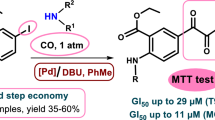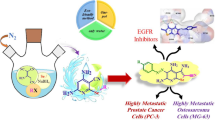Abstract
Two new 4-methylcoumarin derivatives (3a–f and 4a–f) were designed, synthesized, and evaluated for their cytotoxic activity. Different spectroscopic methods and elemental analyses confirmed all the synthesized derivatives’ characterization. All the prepared compounds were biologically screened against four cancer cell lines (hepatocellular carcinoma HepG-2, colon cancer cell lines HCT-116, breast cancer cell lines MCF-7, and prostate cancer cell lines PC3). The in vitro antiproliferative activity of the target analogues 4b, 4c, 4f, 3b, and 3d against the MCF-7 cancer cell line was significant, with IC50 values of 3.98, 7.80, 10.94, 17.7, and 24.07 μM, respectively. Furthermore, the potent cytotoxic oxime derivative 4b was evaluated for cell cycle analysis showing a significant substantial disruption in cell cycle profile and cell cycle arrest at the S phase boundary with a time-dependent rise in a pre-G cell population, as well as a 22-fold increase in MCF-7 apoptosis compared to control cells. Accordingly, the Bax/Bcl-2 ratio, a critical ratio in controlling cell sensitivity to apoptosis, increased upon treatment with the oxime analog 4b. A docking investigation was conducted within the BcL-2 binding site to explore and anticipate the binding modes of the synthesized compounds. Thus, synthesizing these novel coumarin/nitric oxide hybrids may aid in developing promising antiproliferative agents.
Graphical abstract







Similar content being viewed by others
References
Bronikowska J, Szliszka E, Jaworska D, Czuba ZP, Krol W (2012) The coumarin psoralidin enhances anticancer effect of tumor necrosis factor-related apoptosis-inducing ligand TRAIL. Molecules 17:6449–6464. https://doi.org/10.3390/molecules17066449
Devji T, Reddy C, Woo C, Awale S, Kadota S, Carrico-Moniz D (2011) Pancreatic anticancer activity of a novel geranylgeranylated coumarin derivative. Bioorg Med Chem Lett 19:5770–5773. https://doi.org/10.1016/j.bmcl.2011.08.005
Joao Matos M, Vazquez-Rodriguez S, Santana L, Uriarte E, Fuentes-Edfuf C, Santos Y, Munoz-Crego A (2012) Looking for new targets: simple coumarins as antibacterial agents. Med Chem 8:1140–1145. https://doi.org/10.2174/1573406411208061140
Nargotra A, Sharma S, Alam MI, Ahmed Z, Bhagat A, Taneja SC, Qazi GN, Koul S (2011) In silico identification of viper phospholipaseA2 inhibitors: validation by in vitro, in vivo studies. J Mol Model 17:3063–3073. https://doi.org/10.1007/s00894-011-0994-7
Chimenti F, Bolasco A, Secci D, Bizzarri B, Chimenti P, Granese A, Carradori S (2010) Synthesis and characterization of new 3-acyl-7-hydroxy-6,8-substituted-coumarin and 3-acyl-7-benzyloxy-6,8-substituted-coumarin derivatives. J Heterocyclic Chem 47:729–732
Bansal Y, Sethi P, Bansal G (2013) Coumarin: a potential nucleus for anti-inflammatory molecules. Med Chem Res 22:3049–3060. https://doi.org/10.1007/s00044-012-0321-6
Weight S, Huebler N, Strecker R, Braunbeck T, Broschard TH (2012) Developmental effects of coumarin and the anticoagulant coumarin derivative warfarin on zebrafish Danio rerio embryos. Reprod Toxicol 33:133–141. https://doi.org/10.1016/j.reprotox.2011.07.001
Valdir CF (2012) Plant bioactive and drug discovery: principles, practice, and perspectives. Wiley, Hoboken, pp 161–166
Amin KM, Awadalla FM, Eissa AA, Abou-Seri SM, Hassan GS (2011) Design, synthesis and vasorelaxant evaluation of novel coumarin–pyrimidine hybrids. Biorg Med Chem 19:6087–6097. https://doi.org/10.1016/j.bmc.2011.08.037
Basanagouda M, Jambagi VB, Barigidad NN, Laxmeshwar SS, Devaru V (2014) Synthesis, the structure-activity relationship of iodinated-4-aryloxymethyl-coumarins as potential anti-cancer and anti-mycobacterial agents. Eur J Med Chem 74:225–233. https://doi.org/10.1016/j.ejmech.2013.12.061
Lin MH, Cheng CH, Chen KC, Lee WT, Wang YF, Xiao CQ, Lin CW (2014) Induction of ROS-independent JNK-activation-mediated apoptosis by a novel coumarin-derivative DMAC, in human colon cancer cells. Chem Biol Interact 218:42–49. https://doi.org/10.1016/j.cbi.2014.04.015
Saidu NEB, Valente S, Bana E, Kirsch G, Bagrel D, Montenarh M (2012) Coumarin polysulfides inhibit cell growth and induce apoptosis in HCT116 colon cancer cells. Biorg Med Chem 20:1584–1593. https://doi.org/10.1016/j.bmc.2011.12.032
Geisler J, Sasano H, Chen S, Purohit A (2011) Steroid sulfatase inhibitors: promising new tools for breast cancer therapy? J Stero Biochem Mol Biol 125:39–45. https://doi.org/10.1016/j.jsbmb.2011.02.002
Al-Wahaibi LH, Abu-Melha HM, Ibrahim DA (2018) Synthesis of novel 1,2,4-triazolyl coumarin derivatives as potential anticancer agents. J Chem. https://doi.org/10.1155/2018/5201374
Abdolmohammadi S, Afsharpour M, Keshavarz-Fatideh S (2014) An efficient green synthesis of 3-amino-1H-chromenes catalysed by ZnO nanoparticles thin-film. S Afr J Chem 67:203–210
Abdolmohammadi S (2018) TiO2 NPs-coated carbone nanotubes as a green and efficient catalyst for the synthesis of [1]benzopyrano[b][1]benzopyranones and xanthenols in water. Comb Chem High Throughput Screen 21:594–601. https://doi.org/10.2174/1386207321666181018164739
Samani A, Abdolmohammadi S, Otaredi-Kashani A (2018) Green synthesis of xanthenone derivatives in aqueous media using TiO2-CNTs nanocomposite as an eco-friendly and re-usable catalyst. Comb Chem High Throughput Screen 21:111–116. https://doi.org/10.2174/1386207321666180219151705
Abdolmohammadi S (2013) Solvent-free synthesis of 4,5-dihydropyrano[c]chromene derivatives over TiO2 nanoparticles as an economical and efficient catalyst. Curr Catal 2:116–121. https://doi.org/10.2174/2211544711302020005
Fakheri-Vayeghan S, Abdolmohammadi S, Kia-Kojoori R (2018) An expedient synthesis of 6-amino-5-[(4-hydroxy-2-oxo-2H-chromen-3-yl)(aryl)methyl]-1,3-dimethyl-2,4,6(1H,3H)-pyrimidinedione derivatives using Fe3O4@TiO2 nanocomposite as an efficient, magnetically separable, and reusable catalyst. Z Naturforsch B 73:545–551. https://doi.org/10.1515/znb-2018-0030
Chaghari-Farahani F, Abdolmohammadi S, Kia-Kojoori R (2020) PANI-Fe3O4@ZnO nanocomposite: a magnetically separable and applicable catalyst for the synthesis of chromeno-pyrido[d]pyrimidine derivatives. RSC Adv 10:15614–15621. https://doi.org/10.1039/d0ra01978j
Abdolmohammadi S, Ghiasi R, Ahmadzadeh-Vatani S (2016) A highly efficient CuI nanoparticles catalyzed synthesis of tetrahydrochromenediones and dihydropyrano[c]chromenediones under grinding. Z Naturforsch B 71:777–782. https://doi.org/10.1515/znb-2015-0195
Alshabanah LA, Al-Mutabagani LA, Gomha SM, Ahmed HA (2022) Three-component synthesis of some new coumarin derivatives as anticancer agents. Front Chem 9:762248. https://doi.org/10.3389/fchem.2021.762248
Wang C, Xi D, Wang H, Liang L, Xu F, Peng Y, Xu P (2020) Hybrids of MEK inhibitor and NO donor as multitarget antitumor drugs. Eur J Med Chem 196:112271. https://doi.org/10.1016/j.ejmech.2020.112271
Kamath PR, Sunil D, Ajees A, Pai KSR, Das S (2015) Some new indole–coumarin hybrids; synthesis, anticancer and Bcl-2 docking studies. Bioorg Chem 63:101–109. https://doi.org/10.1016/j.bioorg.2015.10.001
El-Sherief HA, Abu-Rahma GA, Shoman ME, Beshr EA, Abdel-baky RM (2017) Design and synthesis of new coumarin–chalcone/NO hybrids of potential biological activity. Med Chem Res 20:3077–3090. https://doi.org/10.1007/s00044-017-2004-9
Vasudevan D, Thomas DD (2014) Insights into the diverse effects of nitric oxide on tumor biology. Vitam Horm 96:265–298. https://doi.org/10.1016/B978-0-12-800254-4.00011-8
Fukumura D, Kashiwagi S, Jain RK (2006) The role of nitric oxide in tumor progression. Nat Rev Cancer 6:521–534. https://doi.org/10.1038/nrc1910
Maciag AE, Holland RJ, Cheng YSR, Rodriguez LG, Saavedra JE, Anderson LM, Keefer LK (2013) Nitric oxide-releasing prodrug triggers cancer cell death through deregulation of cellular redox balance. Redox Biol 6:115–124. https://doi.org/10.1016/j.redox.2012.12.002
Forrester K, Ambs S, Lupold SE, Kapust RB, Spillare EA, Weinberg WC, Felley-Bosco E, Wang XW, Geller DA, Tzeng E (1996) Nitric oxide-induced p53 accumulation and regulation of inducible nitric oxide synthase expression by wild-type p53. Proc Natl Acad Sci 93:2442–2447. https://doi.org/10.1073/pnas.93.6.2442
Michel T, Feron O (1997) Nitric oxide synthases: which, where, how, and why? J Clin Invest 100:2146–2152. https://doi.org/10.1172/JCI119750
Sessa WC (1994) The nitric oxide synthase family of proteins. J Vasc Res 31:131–143. https://doi.org/10.1159/000159039
El-Sherief HA, Youssif BG, Bukhari SNA, Abdelazeem AH, Abdel-Aziz M, Abdel-Rahman HM (2018) Synthesis, anticancer activity and molecular modeling studies of 1, 2, 4-triazole derivatives as EGFR inhibitors. Eur J Med Chem 156:774–789. https://doi.org/10.1016/j.ejmech.2018.07.024
Gomaa HA, El-Sherief HA, Hussein S, Gouda AM, Salem OI, Alharbi KS, Hayallah AM, Youssif BG (2020) Novel 1, 2, 4-triazole derivatives as apoptotic inducers targeting p53: Synthesis and antiproliferative activity. Bioorg Chem 105:104369. https://doi.org/10.1016/j.bioorg.2020.104369
Torgovnick A, Schumacher B (2015) DNA repair mechanisms in cancer development and therapy. Front Genet 6:157. https://doi.org/10.3389/fgene.2015.00157
Wang T, Zhang Y, Kong XW, Lai YS, Ji H, Chen YP, Peng SX (2009) Synthesis and biological evaluation of nitric oxide-donating thalidomide analogues as anticancer agents. Chem Biodivers 6(466):474. https://doi.org/10.1002/cbdv.200800014
Sathishkumar N, Sathiyamoorthy S, Ramya M, Yang DU, Lee HN, Yang DC (2012) Molecular docking studies of anti-apoptotic BCL-2, BCL-XL, and MCL-1 proteins with ginsenosides from Panax ginseng. J Enzyme Inhib Med Chem 27(685):692. https://doi.org/10.3109/14756366.2011.608663
Tsikas D (2007) Analysis of nitrite and nitrate in biological fluids by assays based on the Griess reaction: appraisal of the Griess reaction in the l-arginine/nitric oxide area of research. J Chromatogr B 851(51):70. https://doi.org/10.1016/j.jchromb.2006.07.054
Velázquez C, Praven Rao PN, McDonald R, Knaus EE (2005) Synthesis and biological evaluation of 3,4-diphenyl-1,2,5-oxadiazole-2-oxides and 3,4-diphenyl-1,2,5-oxadiazoles as potential hybrid COX-2 inhibitor/nitric oxide donor agents. Bioorg Med Chem 13(2749):2757. https://doi.org/10.1016/j.bmc.2005.02.034
Kandil S, Westwell AD (2016) 7-Substituted umbelliferone derivatives as androgen receptor antagonists for the potential treatment of prostate and breast cancer. Bioorg Med Chem Lett 26:2000. https://doi.org/10.1016/j.bmcl.2016.02.088
Behl C, Ziegler C (2013) Cell aging: molecular mechanisms and implications for disease. Springer briefs in molecular medicine. Springer, New York
Abou-Zied HA, Youssif BG, Mohamed MF, Hayallah AM, Abdel-Aziz M (2019) EGFR inhibitors, and apoptotic inducers: design, synthesis, anticancer activity and docking studies of novel xanthine derivatives carrying chalcone moiety as hybrid molecules. Bioorg chem 89:102997. https://doi.org/10.1016/j.bioorg.2019.102997
Nemr MT, AboulMagd AM, Hassan HM, Hamed AA, Hamed MI, Elsaadi MT (2021) Design, synthesis and mechanistic study of new benzenesulfonamide derivatives as anticancer and antimicrobial agents via carbonic anhydrase IX inhibition. RSC Adv 11(26241):26257. https://doi.org/10.1039/D1RA05277B
Green DR, Kroemer G (2004) The pathophysiology of mitochondrial cell death. Science 305(626):629. https://doi.org/10.1126/science.1099320
Reed J (2006) Proapoptotic multidomain Bcl-2/Bax-family proteins: mechanisms, physiological roles, and therapeutic opportunities. Cell Death Differ 13(1378):1386. https://doi.org/10.1038/sj.cdd.4401975
Green DR (2006) At the gates of death. Cancer Cell 9(328):330. https://doi.org/10.1016/j.ccr.2006.05.004
Basanagouda M, Jambagi VB, Barigidad NN, Laxmeshwar SS, Devaru V (2014) Synthesis, the structure activity relationship of iodinated-4-aryloxymethyl-coumarins as potential anti-cancer and anti-mycobacterial agents. Eur J Med Chem 74(225):233. https://doi.org/10.1016/j.ejmech.2013.12.061
Keerthy HK, Manoj Garg M, Mohan CD, Madan V, Kanojia D, Shobith R, Nanjundaswamy S, Mason DJ, Bender A, Basappa RKS, Phillip Koeffler H (2014) Synthesis and characterization of novel 2-amino-chromene-nitriles that target Bcl-2 in acute myeloid leukemia cell lines. PLoS ONE 9:e107118. https://doi.org/10.1371/journal.pone.0107118
Acknowledgements
The authors would like to thank Nahda University, Beni-Suef, Egypt and Deraya University, Minia, Egypt, for their support.
Funding
The authors extend their appreciation to the Deanship of Scientific Research at Jouf University for funding this work through research Grant No. (DSR-2021-01-0221).
Author information
Authors and Affiliations
Contributions
Manuscript writing, AMA, HA, MS, OAA, SLA and HH; biological work, chemical work, HA, AMA, SLA, and HH; design and supervision, AMA, OAA, and HA. All authors have read and agreed to the published version of the manuscript.
Corresponding authors
Ethics declarations
Conflict of interest
The authors declared no conflict of interest.
Additional information
Publisher's Note
Springer Nature remains neutral with regard to jurisdictional claims in published maps and institutional affiliations.
Supplementary Information
Below is the link to the electronic supplementary material.
Rights and permissions
Springer Nature or its licensor (e.g. a society or other partner) holds exclusive rights to this article under a publishing agreement with the author(s) or other rightsholder(s); author self-archiving of the accepted manuscript version of this article is solely governed by the terms of such publishing agreement and applicable law.
About this article
Cite this article
Mohamed, M.S., Elsherief, H.A.M., Hafez, H.M. et al. Synthesis, antiproliferative activity, and molecular modeling of novel 4-methylcoumarin derivatives and/or nitric oxide donor hybrids. Mol Divers 27, 2133–2146 (2023). https://doi.org/10.1007/s11030-022-10547-w
Received:
Accepted:
Published:
Issue Date:
DOI: https://doi.org/10.1007/s11030-022-10547-w




